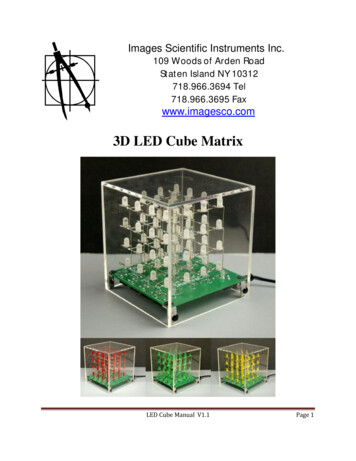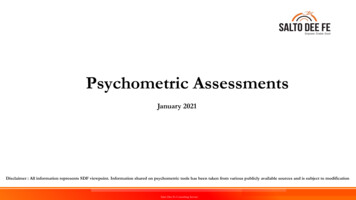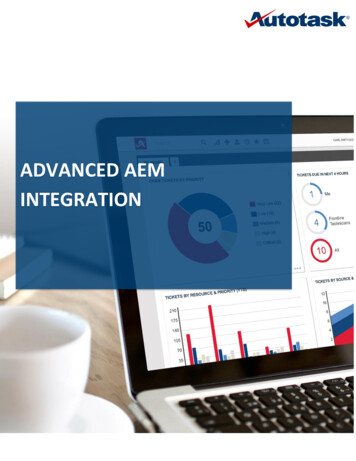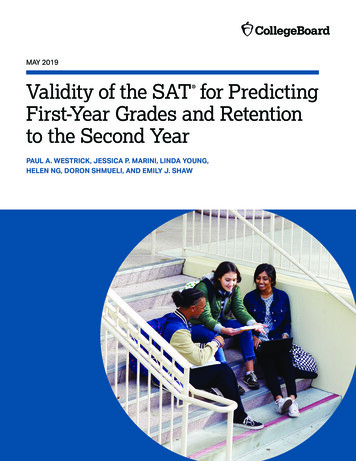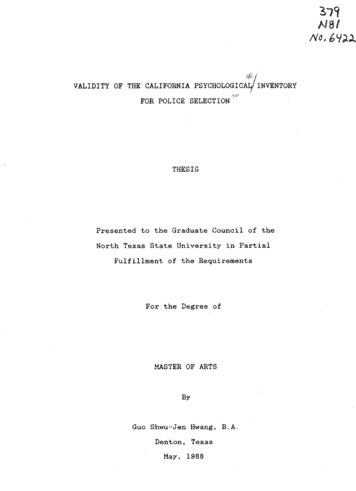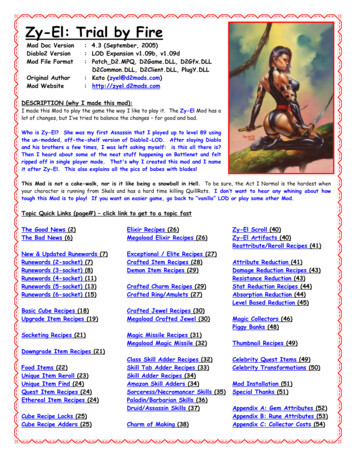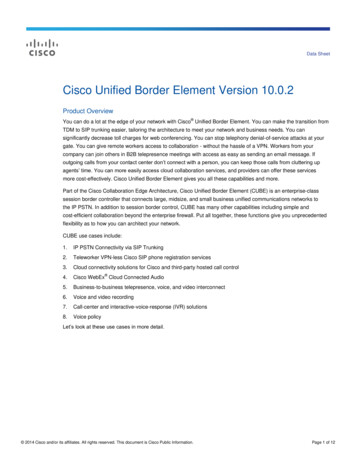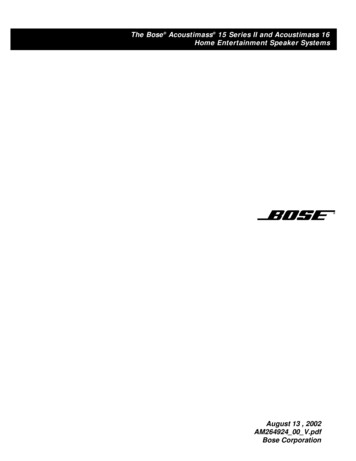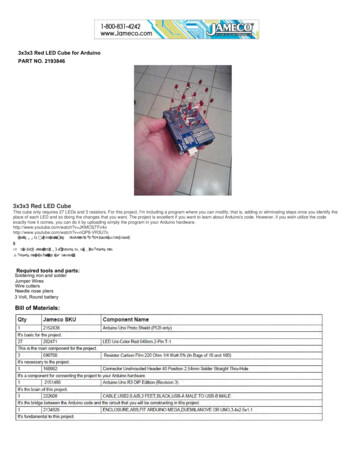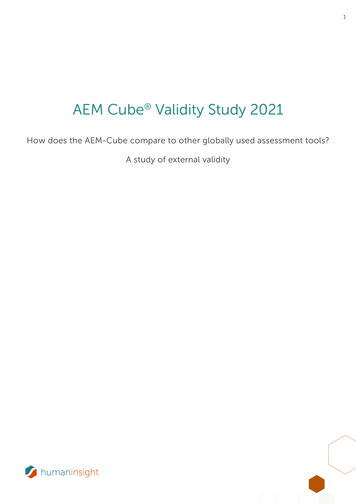
Transcription
1AEM Cube Validity Study 2021How does the AEM-Cube compare to other globally used assessment tools?A study of external validity
3IndexIntroduction4The AEM-Cube4NEO-PI-34Hogan Personality Inventory (HPI)4DISC5Methods5Results & Discussion6AEM-Cube and NEO-PI-36AEM-Cube and Hogan Personality Inventory (HPI)8AEM-Cube and the DISC Model10Conclusion12References13
4IntroductionSeveral consultants, coaches, and practitioners workingIt must be mentioned that the AEM-Cube is unique bywith the AEM-Cube have recently indicated an interest initself since it is the only assessment tool that connectshow the AEM-Cube dimensions relate to dimensions ofpeoples natural tendencies to the strategic needs of another frequently used instruments, such as the NEO-PI-3organisation. By doing so, it provides valuable information(also known as Five-Factor Model, OCEAN or Big Five;for composing optimal teams, restructuring anCosta & McCrae, 1992), the Hogan Personality Inventoryorganisation, or enhancing one’s personal contributions.(HPI; Hogan & Hogan, 1992), and the DISC TheoryDue to the AEM-Cube’s uniqueness, it cannot be(Marston, 2013). Investigating the relationship betweensubstituted by other questionnaires. Nevertheless, itsthe AEM-Cube and these questionnaires might providecorrelations with other questionnaires can providevaluable insight into the traits underlying the AEM-Cubeevidence for its underlying constructs, and its use indimensions.strategic growth and human resources management.The AEM-CubeNEO-PI-3The AEM-Cube is a well-validated assessment instrumentThe NEO-PI-3 is a personality inventory measuringmeasuring how individuals naturally contribute tothe traits Openness to Experience, Conscientiousness,change and growth within a team or organisationExtraversion, Agreeableness, and Neuroticism (Costa &(Robertson, 2005). It emerged from research into diversityMcCrae, 1992). These five traits have been discoveredmanagement (Robertson, 1999) and is based on a strongusing factor analysis and are also known as the OCEANtheoretical foundation of concepts such as attachmentmodel or the Big-5 (Goldberg, 1990). This five-factortheory (Ainsworth et al., 1978; Bowlby, 1969), feedbackmodel of personality is widely accepted, well-validated,and feed-forward systems (Pribram & Merton, 1976),and considered reliable in many different cultures (Costa &and complexity theory (Ashby, 1956). These conceptsMcCrae, 2008).translate to the AEM-Cube dimensions of Attachment,Exploration, and Managing Complexity, which have beenHogan Personality Inventory (HPI)shown to predict team performance (Reynolds & Lewis,The HPI was developed based on the Big-5, but measures2017, Reynolds & Lewis, 2018). As a result, the AEM-Cubeseven primary scales, which are Adjustment, Ambition,is a popular tool in career and talent coaching, investor-Sociability, Interpersonal Sensibility (Likability), Prudence,start-up cooperation, and strategic Human ResourcesInquisitiveness (Intellectance), and Learning Approachmanagement (Robertson & Schoonman, 2013).(School Success) (Hogan & Hogan, 1992). It is a widelyrecognised and often used personality inventory(Anderson & Ones, 2003) and has been shown to predictbusiness intelligence (Akhtar et al., 2015).Figure 1. The AEM-Cube
5DISCSociability dimension of the HPI-IPIP. This would meanThe DISC Theory of Personality describes humanthat individuals with a high relationship focus should alsopersonality in the four dimensions Dominance, Influence,have high levels of Extraversion and Sociability. Likewise,Steadiness, and Compliance (Marston, 2013). It isthe AEM-Cube’s Exploration dimension is expectedfrequently used in corporate and organisational settingsto show a positive correlation with the Openness to(Reynierse et al., 2000) and can predict an individual’s jobExperience dimension of the NEO-PI-3-IPIP, since theysuccess (Deviney, 2010).both measure how much someone seeks out new andstimulating experiences.The goal of this study is, to investigate the AEM-Cube’svalidity by assessing its convergent and divergentDivergent validity is defined by the absence of correlationsvalidity. Convergent validity is defined as the correlationbetween dimensions that measure unrelated constructs.between two dimensions that measure the same or aFor instance, since the Attachment dimension does notsimilar construct. For example, it would be expectedmeasure how creative, strategic and quick someone acts,that the AEM-Cube’s Attachment dimension, with lowit should not correlate with the Inquisitive dimension ofscores representing a content focus and high scoresthe HPI-IPIP. In a similar way, the Exploration dimensiona relationship focus, shows a positive correlation withdoes not measure how friendly, empathetic and tactfulthe Extraversion dimension of the NEO-PI-3-IPIP sincesomeone is and is therefore expected to not be correlatedthey both measure the degree to which someonewith the Agreeableness dimension of the NEO-PI-3-enjoys socialising with people. Similarly, the AttachmentIPIP. No hypotheses are made regarding the Managingdimension should also correlate positively with theComplexity dimension since this dimension is uniquein its learnable nature from the dimensions of otherquestionnaires.MethodData were collected by administering a web-based surveyTo not artificially increase correlations, missing valuesconsisting of the AEM-Cube 36-item version, the NEO-were imputed with the mean of the respective question.PI-3 (IPIP version), the HPI (IPIP version), and the DISCAs the assumptions of normal distributions and a linearquestionnaire as described by Jones & Hartley (2013). 113relationship between both variables were met for allparticipants completed the survey for which they receiveddimensions, Pearson’s r correlation coefficient and theira free AEM-Cube report and the possibility of winning arespective significance values were used to assess theirgift card. The participants represented a balanced sampleassociations. For all correlation coefficients, the 95%of the general population, with 58 being female, 54 beingconfidence interval was computed using bootstrappingmale, and 2 preferred not to disclose their gender. 70%with 1000 replications.of participants were between 18 and 29 years old, 23%between 30 and 49, 5% between 50 and 69, and 2% olderthan 70. While most participants were from Europe, a fewparticipants from Asia, North America, and the Middle Easttook part in the study.
6Results & DiscussionAEM-Cube and NEO-PI-3As hypothesised, individuals having a high relationshipfocus also score significantly higher on Extraversion,Asuggesting convergent validity since both dimensionsNeuroticismExtraversionMmeasure how much someone is oriented towards socialConscientiousnessAgreeablenesssituations. As it was also hypothesised, exploratoryindividuals score significantly higher on Openness toExperience, which also provides evidence for convergentOpennesstoExperiencevalidity because both dimensions measure the degree towhich someone seeks out novel experiences. Evidenceof divergent validity is provided by the non-significantEcorrelations. These suggest that the Attachmentdimension is independent of the Conscientiousnessand the Neuroticism dimension, that the ExplorationPositive correlationNegative correlationFigure 2.dimension is independent of the Conscientiousnessdimension and the Agreeableness dimension, and that theManaging Complexity dimension is independent of theOpenness to Experience dimension.Additionally, some non-hypothesised, but noteworthymeasures to some degree how much someone enjoyscorrelations have been found. Individuals with a highseeking out contact with people, and that the Attachmentrelationship focus score higher on the Agreeablenessdimension to some degree measures how muchdimension. As the Agreeableness dimension measuressomeone likes to make novel experiences. The correlationhow kind, cooperative, considerate, and conflict-coefficients and their respective 95% confidence intervalsavoidant someone is, this indicates that the Attachmentcan be found in Table 1.dimension measures these traits to some degree. Thisfinding can be interpreted as evidence of convergentThese results provide evidence of convergent andvalidity since these traits go well with a focus on personaldivergent validity of the AEM-Cube questionnaire. Theyrelationships. Moreover, more generalist individuals scoreshow that the Attachment dimension can explain anhigher on Conscientiousness and lower on Neuroticism.individual’s levels of Extraversion and Agreeableness,This indicates that more generalist individuals are morewhile the Exploration dimension can explain one’sself-disciplined, achievement striven, and dutiful, but lesslevel of Openness to Experience, and the Managinganxious, hostile and impulsive, while the opposite appearsComplexity dimension one’s level of Neuroticism andto be the case for specialists. Surprisingly, moderateConscientiousness.correlations have been found between Exploration andExtraversion, and between Attachment and Openness toexperience. This suggests that the Exploration dimension
7Table 1Correlations between the AEM-Cube and the NEO-PI-3 dimensionsNEO-PI-R (OCEAN)AEM-Cube dimensionsAttachmentExplorationManaging ComplexityOpenness to Experience.216*[.010, .403].325**[.157, .479]-.076[-.245, .091]Conscientiousness-.073[-.257, .122].011[-.176, .189].636**[.520, .730]Extraversion.407**[.216, .582].325**[.134, .477].219*[.012, .394]Agreeableness.380**[.192, .539].060[-.113, .231].244**[.073, .404]Neuroticism-.159[-.397, .101]-.382**[-.522, -.224]-.437**[-.583, -.261]In each cell, the Pearson’s r correlation coefficient and its 95% Confidence Interval are displayed in the format:[lower boundary, upper boundary]*Correlation is significant at alpha 0.05**Correlation is significant at alpha 0.01
8AEM-Cube and Hogan Personality Inventory(HPI)The hypotheses that a relationship focus can beAassociated with high scores on the Sociability dimensionMSocialibilityAdjustmentcould be confirmed. Since being outgoing, talkative andInterpersonalSensitivityattention-seeking, which is measured by the Sociabilitydimension, goes along well with being focused onAmbitionpersonal relationships, this suggests convergent validity.InquisitiveEvidence for divergent validity is provided by the nonsignificant correlations of Attachment with Adjustment,PrudencePrudence, Inquisitiveness, and Learning Approach.EFurther, the non-significant correlations of Explorationwith Interpersonal Sensitivity and Learning Approach,and of Managing Complexity with Sociability, Prudence,Positive correlationNegative correlationFigure 3.Inquisitive, and Learning Approach provide evidence ofdivergent validity since these dimensions should measureunrelated constructs.Additionally, individuals with a strong relationship focusThese results indicate that the Attachment dimensionalso have higher levels of Interpersonal Sensitivity, whileof the AEM-Cube measures to a moderate degree one’sexploratory individuals score higher on the InquisitiveSociability, and to a strong degree one’s Interpersonaldimension and lower on the Prudence dimension. MoreSensitivity. The Exploration dimension can be used togeneralist individuals are shown to have higher valuesrepresent one’s scores on the Prudence and Inquisitiveon the Adjustment dimension. Since these dimensionsdimension, while the Managing Complexity dimensionmeasure similar constructs, their correlations provideindicates one’s level of Adjustment. The HPI-IPIP Ambitionevidence for great external validity. Interestingly, Ambitiondimension can be explained together with the Explorationshows strong correlations with both the Managingand the Managing Complexity dimension of the AEM-Complexity and the Exploration dimension, meaning thatCube.being exploratory and generalist both goes along withhigh values on the Ambition dimension. The LearningApproach dimension of the HPI-IPIP appears to beindependent of all AEM-Cube dimensions, meaningthat the AEM-Cube does not measure the constructcaptured by this dimension. The correlations between thedimensions and their respective 95% confidence intervalscan be found in Table 2.
9Table 2Correlations between the AEM-Cube and the HPI-IPIP dimensionsHogan Personality Inventory (HPI)AEM-Cube dimensionsAttachmentExplorationManaging ComplexityAdjustment.060[-.158, .262].299**[.122, .470].373**[.198, .512]Ambition.196*[.002, .363].479**[.331, .603].466**[.315, .604]Sociability.355**[.181, .520].239*[.055, .419].032[-.177, .236]Interpersonal Sensitivity.577**[.416, .711].178[-.006, .353].275**[.099, .455]Prudence-.094[-.269, .103]-.512**[-.618, -.395].079[-.192, .331]Inquisitive.002[-.204, .198].462**[.287, .610].068[-.091, .236]Learning Approach-.076[-.274, .120].178[-.026, .365].181[.034, .343]In each cell, the Pearson’s r correlation coefficient and its 95% Confidence Interval are displayed in the format[lower boundary, upper boundary]*Correlation is significant at alpha 0.05**Correlation is significant at alpha 0.01
10AEM-Cube and the DISC ModelThe results displayed in Table 3 indicate that individualswith a strong relationship focus score high on theMAInfluence dimension, suggesting convergent validity sincerelationship-focused individuals could be expected to bemore friendly, sociable and communicative. Exploratoryindividuals score high on the Dominance dimension,Complianceindicating that the Exploration dimension also measureshow independently minded and assertive someone is.SteadinessSimultaneously, exploratory individuals score low onDominancethe Steadiness dimension. This indicates convergentEvalidity since optimising individuals can be expected toprefer a constant and predictable environment. Besidesthis evidence for convergent validity, divergent validity isshown by non-significant correlations of Attachment withDominance and Steadiness, and of Managing Complexitywith Influence. Notably, the Compliance Dimension inthe DISC model is negatively correlated with both theExploration and the Managing Complexity dimension,meaning that individuals who are exploratory andgeneralists score low on Compliance. As a weakness, itmust be pointed out that the Exploration dimension alsoshows a moderate to strong correlation with the Influencedimension. However, it cannot be said whether this meansthat the Exploration dimension measures influence orwhether the Influence dimension measures exploratorybehaviour.These findings indicate that the Attachment dimension ofthe AEM-Cube partially explains the Influence dimensionof the DISC model, while the Exploration dimensionpartially explains Dominance and Steadiness. Both theManaging Complexity and the Exploration dimensiontogether can explain to some degree the Compliancedimension of the DISC model.Positive correlationNegative correlationFigure 4.
11Table 3Correlations between the AEM-Cube and the DISC Model dimensionsAEM-Cube dimensionsExplorationManaging ComplexityDominance-.111[-.316, .112].401**[.242, .540].286**[.107, .453]Influence.446**[.299, .572].403**[.240, .529].089[-.067, .253]Steadiness-.029[-.235, .192]-.322**[-.472, -.139]-.226*[-.391, -.058]Compliance-.222*[-.383, -.037]-.599**[-.701, -.488]-.331**[-.487, -.164]DISCAttachmentIn each cell, the Pearson’s r correlation coefficient and its 95% Confidence Interval are displayed in the format[lower boundary, upper boundary]*Correlation is significant at alpha 0.05**Correlation is significant at alpha 0.01
12ConclusionThis study evaluated the AEM-Cubes validity byinvestigating how its dimensions correlate with thedimensions of other globally used assessment tools.Great convergent validity could be found as the AEMCube dimensions show moderate to strong correlationswith the dimensions of other assessment tools whichmeasure the same or similar constructs. Individualswith a high relationship focus also have high levelsof Extraversion and Agreeableness (NEO-PI-3-IPIP),Sociability and Interpersonal Sensitivity (HPI-IPIP) andInfluence (DISC Model). Exploratory individuals have highlevels of Openness to Experience (NEO-PI-3-IPIP), scorehigh on Inquisitive and Ambition, but low on Prudence(HPI-IPIP), and high on Dominance but low on Steadinessand Compliance (DISC-Model). Last, more generalistindividuals score higher on Conscientiousness and loweron Neuroticism (NEO-PI-3-IPIP), higher on Adjustmentand Ambition (HPI-IPIP), but lower on Compliance (DISCModel). This evidence of convergent validity indicates thatthe AEM-Cube dimensions indeed measure the constructsof Attachment, Exploration, and Managing Complexity.Further, evidence of divergent validity was found since theAEM-Cube dimensions did not correlate with dimensionsthat measure unrelated constructs, indicating the AEMCube dimensions do not measure constructs other thanthe ones they are supposed to measure. This evidenceof external validity further justifies the use of the AEMCube as an assessment tool in an organisational context.Going beyond external validity, the associations foundin this study can also be used to guide practitioners,coaches, and consultants who are familiar with otherassessment tools. They can use these insights to createa more comprehensive understanding of an individual’spersonality based on one’s AEM-Cube profile.
13ReferencesAinsworth, M. D., Blehar, M. C., Waters, E., & Wall, S. N. (2015). Patterns of attachment: A psychological study of the strangesituation. Psychology Press.Anderson, N., & Ones, D. S. (2003). The construct validity of three entry level personality inventories used in the UK:Cautionary findings from a multiple-inventory investigation. European Journal of Personality, 17(1), 39-66. https://doi.org/10.1002/per.484Ashby, W. R. (1956). An introduction to cybernetics. New York: John Wiley & Sons Inc.Bowlby, J. (1969). Attachment and loss: Attachment. New York: Basic Books.Costa, P. T., & McCrae, R. R. (1992). Revised NEO personality inventory (NEO PI-R) and NEO five-factor inventory (NEO-FFI):Professional manual. Odessa, FL: Psychological Assessment Resources.Costa, P.T., & McCrae, R.R. (2008). The Revised NEO PersonalityInventory (NEO-PI-R). The SAGE handbook of personalitytheory and assessment, 2, 135-178Goldberg, L. R. (1990). An alternative “description of personality”: The big-five factor structure. Journal of Personality andSocial Psychology, 59(6), 1216-1229. https://doi.org/10.1037/0022-3514.59.6.1216Jones, C. S., & Hartley, N. T. (2013). Comparing correlations between four-quadrant and five-factor personality assessments.American Journal of Business Education (AJBE), 6(4), 459-470. https://doi.org/10.19030/ajbe.v6i4.7945Marston, W. M. (2013). Emotions of normal people (Vol. 158). Routledge.Pribram, K. H., & Merton, M. G. (1976). Freud’s project reassessed. Hutchinson Radius.Reynolds, A. & Lewis, D. (2017, March 30). Teams solve problems faster when they’re more cognitively diverse. HarvardBusiness Review. r-when-theyre-more-cognitively-diverse (accessed18 November 2020).Reynolds, A. & Lewis, D. (2018, April 2). The two traits of the best problem-solving teams. Harvard Business Review. -problem-solving-teams (accessed 10 March 2021).Robertson, P. P. (1999). The AEM-Cube : A management tool, based on ecological concepts, in order to profit from diversity.SSRN Electronic Journal. https://doi.org/10.2139/ssrn.3220244Robertson, P. P. (2005). Always change a winning team: Why reinvention and change are prerequisites for business success.Cyan Books.Robertson, P. P., & Schoonman, W. (2013). How people contribute to Growth-Curves. SSRN Electronic Journal. https://doi.org/10.2139/ssrn.2291325
The Hague - Spaces Rode OlifantLondon - St. James HouseZuid Hollandlaan 7 - 2596 AL The HagueThe Netherlands 31 (0)85 3 Kensington Square - London W8 5HDUnited Kingdom 31 (0)85 8229827info@human-insight.comwww.human-insight.com
Hogan Personality Inventory (HPI) The HPI was developed based on the Big-5, but measures seven primary scales, which are Adjustment, Ambition, Sociability, Interpersonal Sensibility (Likability), Prudence, Inquisitiveness (Intellectance), and Learning Approach (School Success) (Hogan

